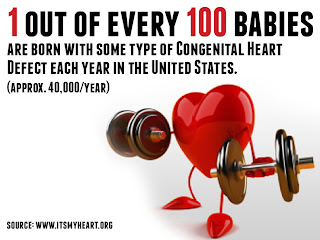Happy Valentine's Day, bitches!
It's supposedly the most romantic day of the year, when your love (or your love-to-be) spends an exorbitant amount of money on chocolates, jewelry and dinners with pre-fixe menus and jacked up prices.
I've never been a fan of this day, even now that I'm married. Our wedding anniversary is only 2 weeks away, so we don't tend to make a big deal. I mean, I'll
I ain't mad about it, just as long as I get a card. I'm a sucker for a good card.
Steve & I on our first Valentine's Day, 2006. Yes, that's a picture of a picture.
I'm not here to whisper sweet romantic nothings in your ear today, I'm here to tell you some important business.
HAPPY CONGENITAL HEART DEFECT AWARENESS DAY!!
That's right folks, those of us who were born with broken tickers get to share this day with St. Valentine himself! And while I think love and cupid and flowers (oh my!) are wonderful things, I think being educated on something that probably affects or will affect anyone reading (you may just not know it), is SO SO SO very important!
1.
Congenital heart defects occur in the early stages of pregnancy when the heart is forming. They include abnormalities in the heart's structure, electrical system, and other abnormalities that affect the function of a baby's heart.
depending on where you read, that number ranges from 1-100 to 1-120.
2.
Congenital heart defects are the most common type of birth defect, and is the leading cause of infant death. In the US, twice as many children die from congenital heart defects each year than from all forms of childhood cancer combined. Yet, funding for pediatric cancer research is five times higher than funding for CHD.
3.
It is estimated that at least 400 infants with an unrecognized CHD are discharged each year from newborn nurseries in the United States. Pulse oximetry is a simple, inexpensive, non-invasive test done at the bedside to determine the percentage of oxygen in the blood. Low levels in the blood can indicate a critical CHD. Many states have mandated pulse oximetry be performed on every newborn prior to discharge home, but it is still not mandated in all 50 states!
4.
There are more than 40 different types of congenital heart defects. Little is known about the cause of most of them. There is no known prevention or cure for any of them.
5.
For the first time, due to medical and surgical advancements, 50% of CHD survivors (me!) are adults.
kids with CHD can go from this...
to THIS!
See this guy?
Yeah, that's Olympic gold medalist Shaun White. The Flyin Tomato and I have something in common, we were both born with the same congenital heart defect, tetralogy of Fallot. He gave two big middle fingers to any one who said he couldn't do it, and 1080'd his way to the top. If that's not a big fuck you to the doubters, I don't know what is.
This is an anatomically correct tattoo of what the heart looks like when someone has tetralogy of Fallot. I've been obsessed with this tattoo for YEARS.
There is no way to prevent congenital heart defects, but education is key. I know there are a lot of mommies (and future mommies) who read this blog, so here are 5 questions to ask at your 20 week ultrasound. The more you know!
And there we have it! Here's to a heart-filled day of chocolates and conversation hearts. I hope this leaves you with some new-found knowledge, because while CHD's may not affect you directly, there is no doubt it does to someone you know!
Happy HAPPY Congenital Heart Defect Awareness Day & Valentine's Day from my fixed ticker to yours!!!!
Be sure to check out Kathy's blog because I took that shit over today!
I wrote the same facts, but check out the NE Bloggers Network blog, because I took that one over, too!








